In this post, I take a closer look at the Mont Sainte-Victoire series by Paul Cézanne. Mont Sainte-Victoire is a mountain in France that overlooks Aix-en-Provence (the town where Cézanne was born). Cézanne painted it on numerous occasions during his career. The series not only provides an interesting take on landscape painting, but it also documents Cézanne’s development as an artist during his lifetime. I cover:
- Key Facts
- Color and Light
- Use of Geometric Forms to Paint the Landscape
- Watercolor Paintings of Mont Sainte-Victoire
- A Development in Style
- Unfinished Version
- Key Takeaways
- Want to Learn More?
- Thanks for Reading!
“Cézanne was my one and only master… He was like the father of us all.” Pablo Picasso

(Before diving into this post, make sure to pick up a copy of my free Landscape Painting Starter Kit.)
Key Facts
- The series was painted between 1882 and 1906 and features various perspectives of Mont Sainte-Victoire.
- It is considered part of Post-Impressionism.
- In a letter to Émile Zola dated 14 April 1878, Cézanne described the mountain as “beau motif (beautiful motif)”, after viewing it from the train which runs through the Arc River Valley. You can see the train line in some of the paintings in the series (like the one at the start of this post).
- The series was painted after Cézanne had become frustrated with Impressionism and sought “to make of Impressionism something solid and durable, like the art of museums.”
- Cézanne featured Mont Sainte-Victoire in a less important background role in an earlier work, Bathers at Rest, 1977.
- Below is a photo of the real Mont Sainte-Victoire, along with one of Cézanne’s paintings for comparison.

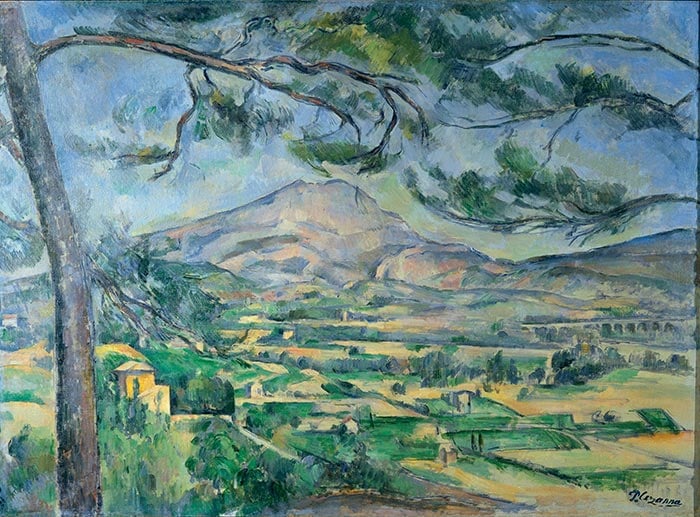
- Here is a photo by Ker-Xavier Roussel of Cézanne in front of his easel (most likely) painting the mountain.

Color and Light
As Cézanne painted this series over many years, the colors he used changed with the different conditions. In the painting below, he made use of ochres and dull greens to paint what appears to be a dry landscape. In many of his other paintings in the series he used richer greens and blues.
In the painting below, there is a pleasant contrast in color temperature between the warm foreground and the cool mountain and sky in the distance. This helps to create a sense of atmospheric perspective. Also, notice the use of common colors between the mountain and sky. If it were not for the outline of the mountain, it would be difficult to tell where the mountain stops and where the sky starts.

Below is one of Cézanne’s later paintings in the series. Richer and darker colors were used in this dramatic version. The yellow building is the Château Noir, a place where Cézanne frequently painted as it provided him with a clear view of the mountain.

Use of Geometric Forms to Paint the Landscape
Many of the paintings in the series feature an interesting use of geometric forms to depict the organic landscape, particularly the later paintings in the series. The painting below is a great example of this. This emphasis on geometric forms paved the way for Cubism.

Watercolor Paintings of Mont Sainte-Victoire
Most of the paintings in the series were created using oils, but Cézanne also painted some looser and almost unfinished versions using watercolors. I always find it interesting how much an artist’s style can change simply with a change of medium. This is because different mediums tend to favor different aspects of painting. Oils are slow-drying and malleable; whereas watercolors are untamed and delicate.

The painting below has a very ethereal feel to it, with the transparent greens and blues. The blues in particular are quite stunning. As with most of his paintings, Cézanne used colorful blues and greens as his darks rather than resorting to browns and blacks.
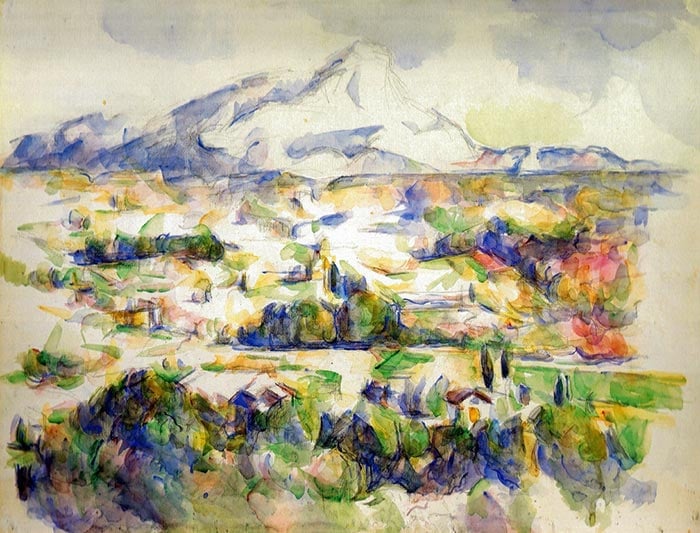
A Development in Style
In my opinion, one of the most interesting aspects of this series is how it shows Cézanne’s development in his artistic style. Here is one of his earlier paintings in the series created in 1885. It was painted in a more reserved style with relatively soft strokes, smooth gradations and accurate detail.

Cézanne painted the following in 1902. As you can see, the colors are richer and the forms are slightly distorted. But the mountain appears grander and more imposing (which may be closer to Cézanne’s idea and vision).

By the end of this series, Cézanne painted the landscape with a strong emphasis on geometric forms and bold colors; far from the more reserved paintings he started the series with. Less realistic but perhaps closer to how Cézanne viewed the mountain and landscape.

Unfinished Version
Here is what appears to be an unfinished painting in the series. It gives you an idea of how Cézanne went about painting the landscape. It seems he started by painting in the darks and midtones using geometric shapes.

Key Takeaways
Here are some of the key takeaways from the Mont Sainte-Victoire series which you could incorporate into your own paintings:
- Painting the same subject over and over again allows you to explore the way color and light work in different conditions. It also allows you to really dive deep into a certain subject. Claude Monet also did this on many occasions, like with his series on water lilies, haystacks and the Rouen Cathedral.
- Try not to trap yourself into a particular style. Always feel free to make adjustments and push the boundaries.
- Using geometric forms to paint the organic landscape can produce some very interesting results.
- Different mediums allow you to capture different aspects of a subject. If you painted a subject using oils, then also try painting it in watercolors as Cézanne did in this series.
Want to Learn More?
You might be interested in my Painting Academy course. I’ll walk you through the time-tested fundamentals of painting. It’s perfect for absolute beginner to intermediate painters.
Thanks for Reading!
I appreciate you taking the time to read this post and I hope you found it helpful. Feel free to share it with friends.
Happy painting!
Dan Scott

Draw Paint Academy

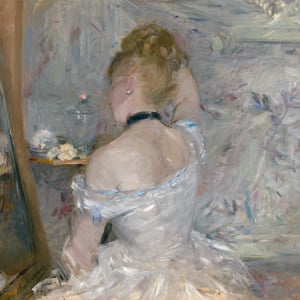
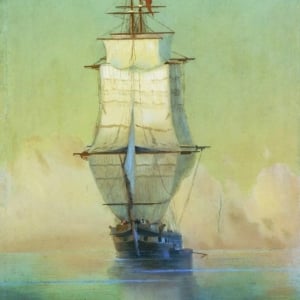

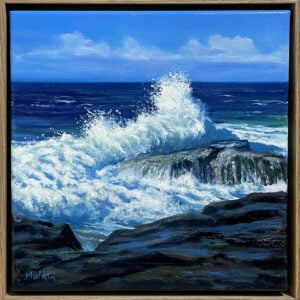

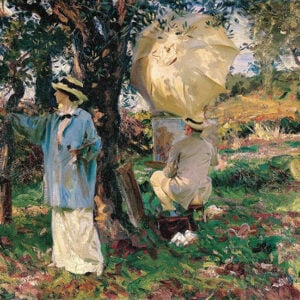
bonjour,
je decouvre l histoire de l art, votre article est tres interressant , dans la maniere de lire un tableau,
debutante en aquarelle j avance a petit pas
merci de prendre le temps, pour ces explications
nathalie lemaire
Thanks Nathalie (and Google translate)!
Merci très intéressant .
Bonne journée.
Thanks Mado!
Cezanne has always been one of my favored artists. I do now watercolor since I am fascinated by the way colors work on their own. The subject of the Mont Sainte-Victoire is one of his favorite
subjects. I find it is very difficult to copy! All of your remarks are absolutely correct and I share
them. This is the first time for me to experience someone´s ideas which I completely share…..
Interesting…. Thank you!
Hi Yolande. That is a great part of watercolors. Glad you share the same thoughts. Thanks! Dan
I just returned from Paris where I took the opportunity to view a special collection of paintings at the Foundation Louis Vuitton. It is a nice exhibit, including works by various impressionist such as Monet, Manet, Seurat and Cezanne. The exhibit is open through June 2019.
Personally, as a painter myself, I see a child-like quality in Cezanne’s work especially in his early years. His work seems to have less mastery in drawing and use of oil paints than other contemporaries of his. None-the-less, I can appreciate his work for being part of the impressionists movement.
I tend to agree, but I still enjoy his work and the history behind it. I am jealous you got a chance to attend that exhibition! Dan
Thank you. This was very interesting.
No problem Elizabeth! Thanks, Dan
Thank you, Dan. I always learn so much from your articles.
Glad to hear Linda! Thanks, Dan
If you ever have the opportunity to visit Cezanne’s studio in Aix-en-Provence, do it. It is fascinating. The props from many of his still lifes are still there and set up as he painted them.
Thanks Carol! Sounds like a great idea, I would love to see this. Dan
Scott, thank you so much for sharing this very valuable insight of Cezanne’s work.
This was an extremely well done overview of the different stages of Cezanne’s painting techniques. I really appreciate the changes that he made with the same subject in the series mainly to the change of the light and choice of his color palette.
Best wishes,
Jean
Hi Jean
Thank you for your kind words!
Glad you enjoyed the post.
Thanks
Dan
In September of 1999, my wife and I rented a house in Puyloubier France, located 20 km east of Aix. It is located at the foot of Mont Sainte-Victoire, on the south face. Daily, as the sun changed during the day, as well as the changing weather day to day, and week to week, the mountain changed colour as its white face reflected the light of the hour. Daily as we went out to visit the surrounding area as tourists do, we drove along its south face marvelling at the sight. On three occasions we drove around it to the north face, to go to Aix. Myself, at that time wasn’t into painting. Now I regret that I didn’t take several hundred digital photographs to study now, since I began painting 18 months ago. But these pictures bring back happy memories of that trip. Thanks Don.
Very fascinating! Thanks for sharing. Dan
I have to admit I like his earlier work better than the latter. Do you think we keep searching because we are looking for an easier way to depict a scene, or are of a nature seldom satisfied with our work as a whole. I have noticed this tendency in other artist, it has caused me to question why I find myself changing my palette and style of painting, over the years, and generally not for the better.
LLoyd
Hi Lloyd
Thanks for pointing that out. I guess many artists are trying to explore new ways to say the same thing. And I don’t think any of us are ever completely satisfied! Thanks, Dan
It is very interesting how many artists paint the same subject over and over. I am very much a beginner but paint a plum tree in my yard over and over…just trying now to get it in the snow! Thank you so much for sharing this article Dan, it is very cool.
No problem Joan! Glad you enjoyed it. Thanks, Dan
Thank you, Dan. This is another great post from you this time giving new insight into Cezanne’ and how he worked. I always learn from you.
Thanks Karen! Happy to hear this. Dan
Thank you for so generously sharing this wonderfully insightful information. I am making my way through your beginner painting class. And I’m growing with leaps and bounds.
Glad to hear Debbie! Happy to be able to help you out. Thanks, Dan
Thanks Dan! Great analysis!
No problem Marie-Victoria! Dan
Thank you, very interesting.
looking at Monet’s now
No problem Rhonda. Dan